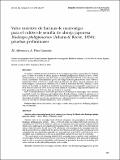Por favor, use este identificador para citar o enlazar a este item:
http://hdl.handle.net/10261/313796COMPARTIR / EXPORTAR:
 SHARE
BASE SHARE
BASE
|
|
| Visualizar otros formatos: MARC | Dublin Core | RDF | ORE | MODS | METS | DIDL | DATACITE | |

| Título: | Valor nutritivo de harinas de macroalgas para el cultivo de la almeja japonesa, Ruditapes philippinarum: pruebas preliminares |
Otros títulos: | Nutritive value of macroalgal meals for the culture of seed clams of the Manila clam Ruditapes philippinarum (Adamsampersand Reeve, 1850): Preliminary results | Autor: | Albentosa, Marina CSIC ORCID; Pérez-Camacho, Alejandro CSIC | Palabras clave: | Centro Oceanográfico de Murcia Dietas alternativas Acuicultura macroalgas semilla almeja japonesa Ruditapes philippinarum crecimiento |
Fecha de publicación: | 1-dic-2002 | Citación: | Boletín. Instituto Español de Oceanografía. 2002. 18 (1-4) | Resumen: | Nutritive value of two macroalgal meals (Undaria sporophytes and gametophytes) for Manila clam Ruditapes philippinarum (Adamsampersand Reeve, 1850) seed culture was studied. Both meals were tested at a substitution level of 50 % of the daily food ration and as single diets; these diets were then compared with the reference diets comprising the microalgae Isochrysis galbana Parke clone T-ISO, either as the entire daily food ration or half of the ration. In both cases, 50 % substitution of the microalgae by the macroalgal meals doubled the growth observed, compared with the reference diet. Moreover, growth rates of the seed clams fed on the substitution diets were statistically comparable, on a dry weight basis, to the 100 % control diet in the case of sporophytes meal, or lightly lower in the case of gametophytes meal (20% lower than the control diet). These results point out the interesting potential of the macroalgal meals as partial or total substitutes of live microalgae. Further future research focused on increasing the substitution level, along with modifying the meals in order to increase their digestibility, could determine the potential of these diets in the feeding of bivalves, and even in other filter-feeding animals, such as rotifers. Se evalúa la calidad nutritiva dos harinas de macroalgas (esporofitos y gametofitos de Undaria) para el cultivo de semilla de almeja japonesa Ruditapes philippinarum (Adamsampersand Reeve, 1850). Ambas harinas se ensayaron como dieta única y como sustitución del 50 % en dos dietas de referencia, constituidas exclusivamente por la microalga Isochrysis galbana Parke clone T-ISO suministrada al 100 y al 50 % de la ración diaria de alimento. En ambos casos, el suministro de la harina duplica el crecimiento observado con la dieta de referencia del 50 %. Además, el crecimiento de la semilla con la dieta de sustitución es estadísticamente comparable, en peso seco, al de la dieta de control al 100 % en el caso de la harina de esporofitos, y ligeramente inferior con la de gametofitos (un 20 % más bajo que la dieta de control). Estos resultados ilustran el interesante potencial de las harinas de macroalgas como alternativa parcial o total a los alimentos microalgales vivos. Estudios futuros relativos al aumento en el nivel de sustitución y sobre la modificación de las harinas para facilitar su digestión permitirán determinar el posible uso de estos productos en la alimentación de los moluscos bivalvos, e, incluso, de otro tipo de animales filtradores, como los rotíferos. |
URI: | http://hdl.handle.net/10261/313796 | ISSN: | 0074-0195 |
| Aparece en las colecciones: | (IEO) Artículos |
Ficheros en este ítem:
| Fichero | Descripción | Tamaño | Formato | |
|---|---|---|---|---|
| 195-195-1-PB.pdf | 90,79 kB | Adobe PDF |  Visualizar/Abrir |
CORE Recommender
Este item está licenciado bajo una Licencia Creative Commons

